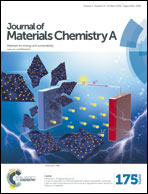N-Doped graphene-coated molybdenum carbide nanoparticles as highly efficient electrocatalysts for the hydrogen evolution reaction†
Abstract
In our efforts to explore promising substitutes for Pt-based electrocatalysts for the hydrogen evolution reaction (HER), a new type of molybdenum carbide nanoparticle coated with graphene shells with nitrogen dopants (abbr. MoCx@C-1) is prepared from an entangled polyoxometalate-encapsulated coordination polymer (PECP), [Zn(bimbp)2]3[PMo12O40]2·2H2O (PECP-1) (bimbp = 4,4′-bis(imidazolyl)biphenyl) via the annealing and etching processes. The synergistic effects between highly dispersive MoCx particles, graphene coatings and N dopants in MoCx@C-1 lead to remarkable HER performance in acidic media with a very positive onset potential close to that of commercial 20% Pt/C catalysts, a low Tafel slope of 56 mV dec−1, a high exchange current density of 0.27 mA cm−2, and superior long-term cycle stability. In particular, MoCx@C-1 exhibiting an overpotential of 79 mV at a current density of 10 mA cm−2 represents one of the currently best reported MoCx-based HER electrocatalysts in acidic media. Such performance is also better than that of uncoated MoCx-2 nanoparticles prepared by carburizing another PECP [Bu4N][Zn3(bimb)4Cl(MoO4)][PMoVMoVI11O40]·4H2O (PECP-2) (bimb = 1,4-bis(1-imidazolyl)benzene). This work provides a new feasible route to prepare nanostructured hybrids composed of transition metal carbides, graphene and N dopants with higher HER activity and stability.


 Please wait while we load your content...
Please wait while we load your content...